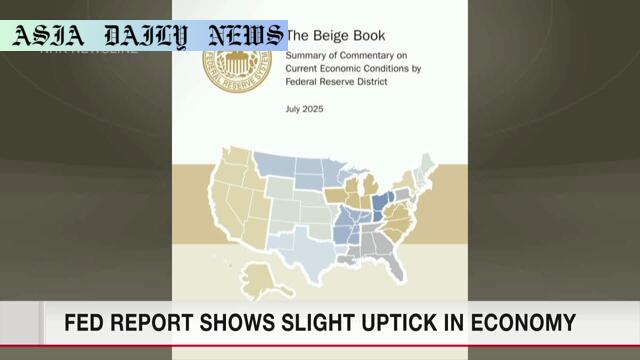Economic Activity: Fed reports slight growth amidst uncertainty from tariffs.
Economic activity across the US showed a slight improvement according to the Federal Reserve’s Beige Book.
Businesses remain cautious due to elevated uncertainty stemming from US tariff policies.
The Fed is preparing for its next monetary policy meeting on July 29.

Overview of the Fed’s Latest Beige Book
The United States Federal Reserve recently released its Beige Book, reporting a slight uptick in economic activity across the nation between late May through early July. The assessment offers a snapshot of economic conditions based on interviews and data gathered from businesses in the Federal Reserve’s 12 districts. According to the report, about half of these regions reported at least a small increase in economic activity, a noteworthy improvement compared to the prior report, which stated that activity had stagnated or declined in many areas.
However, the optimism surrounding this improvement was tempered by continuing concerns over tariffs and their lingering impacts on business confidence and supply chains. The report clearly stated that uncertainty remains elevated, making a strong and consistent economic recovery elusive. These findings are intended to inform members of the Federal Reserve ahead of their next monetary policy analysis meeting on July 29.
The Significance of Slight Economic Growth
This slight increase in activity is, nonetheless, a glimmer of positive news for an economy that has been facing significant headwinds. Businesses around the country have been grappling with the effects of elevated tariffs, particularly in industries reliant on global trade. These disruptions have contributed to a climate of caution and pessimism, underlining the complex interplay between domestic economic policies and global market dynamics. It is against this backdrop that the Federal Reserve’s findings have garnered considerable attention in economic circles.
The Beige Book represents a vital tool for understanding regional trends and fluctuations, and it serves as a barometer for policymakers as they navigate challenges that impact various sectors of the country’s economy. Although slight, this growth signals resilience in certain areas, primarily consumer spending and services, even as uncertainties persist.
The Role of Tariffs and Policy Implications
One of the key drivers of the tempered outlook among businesses is the lingering uncertainty caused by heightened tariffs, a cornerstone of the Trump administration’s economic policy. These tariffs have placed pressure on both importers and exporters, escalating costs and disrupting supply chains in sectors such as manufacturing and agriculture. Many businesses reported being cautious in committing to new investments or expanding operations because of these unresolved tensions in trade.
Policymakers at the Federal Reserve have been closely monitoring these developments to assess the potential impacts on economic growth and inflation. The upcoming Federal Reserve meeting on July 29 will likely address these concerns more definitively, particularly as the agency weighs the implications of prolonged uncertainty on monetary policy and interest rates. Their decisions will be keenly watched by businesses, economists, and investors alike, each of whom is eagerly seeking clarity in these unprecedented times.
What Lies Ahead for the U.S. Economy
With the Federal Reserve adopting a ‘neutral to slightly pessimistic’ outlook, it is clear that caution will remain a key theme in the coming months for both businesses and policymakers. Projections for growth will depend heavily on how trade issues and tariffs are resolved—if at all—and whether these will impact larger areas of the economy. Meanwhile, consumer spending and employment growth continue to provide some level of support to the economy but are not sufficient to generate robust expansion.
The country’s ability to navigate these challenges will depend on a collaborative approach involving both clear policy measures from policymakers and adaptive strategies from businesses. For Americans awaiting stronger stability, patience and adaptability will perhaps be their greatest assets during these uncertain times.



Commentary
A Mixed Message from the Federal Reserve
The latest report from the US Federal Reserve offers a mixed picture of the country’s economic health. On one hand, the slight improvement in activity since late May is an encouraging sign that pockets of the economy are showing resilience. On the other hand, the persistent uncertainty around tariffs and global trade tensions casts a shadow over this progress. It is a stark reminder of how interconnected the global economy has become and how domestic policy decisions can reverberate far beyond national borders.
The Complexity of Tariff-Driven Uncertainty
When considering the impact of tariffs, it is clear that businesses—especially smaller ones—have faced significant challenges. Higher input costs, disrupted supply chains, and the general unpredictability of trade policies have forced many companies to tread carefully. For businesses reliant on imports or exports, this environment has been particularly brutal, with many confronting the hard choice of whether to absorb costs or pass them on to consumers. It is hardly surprising, then, that the Federal Reserve gauges business sentiment as ‘neutral to slightly pessimistic.’
Looking Forward: Opportunities for Stability
The upcoming Federal Reserve meeting presents an opportunity to address some of these pressing issues. While monetary policy alone cannot resolve trade disagreements, the decisions made by policymakers can certainly provide some degree of stability to a volatile situation. For businesses and households alike, gaining clarity—even incremental—can go a long way in fostering confidence and spurring some level of economic activity.
Ultimately, however, the success of these efforts depends on collaborative, well-coordinated actions from all stakeholders involved in the U.S. economy. The road ahead may be uncertain, but a commitment to finding solutions could help mitigate some of these challenges.